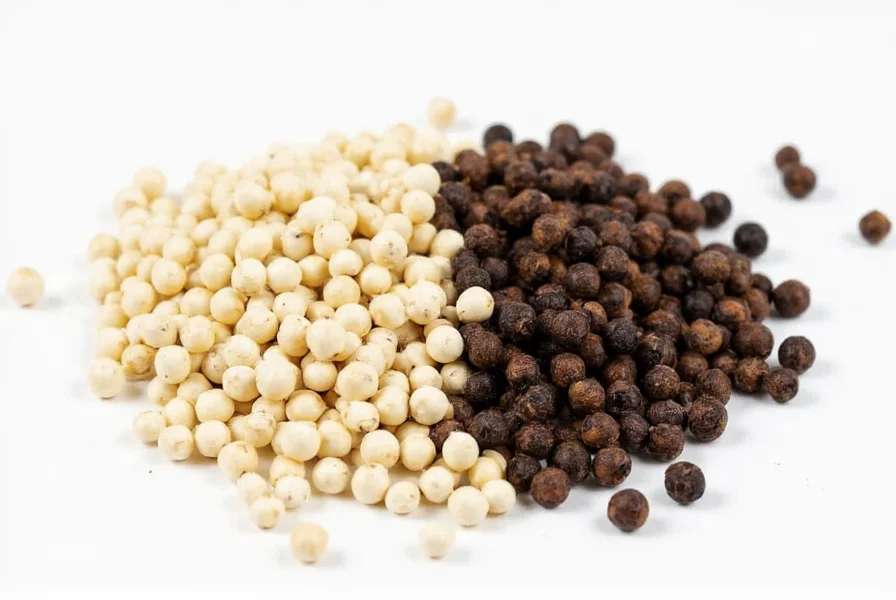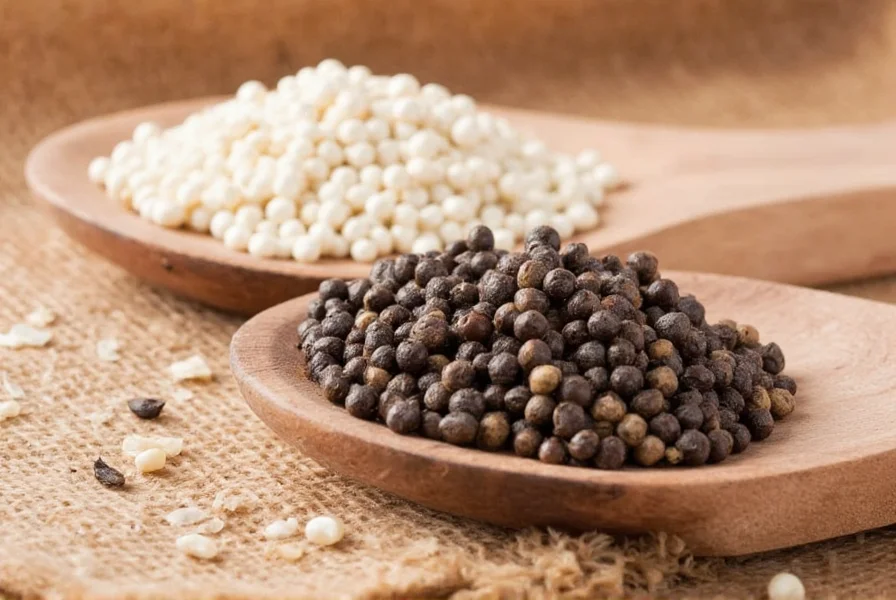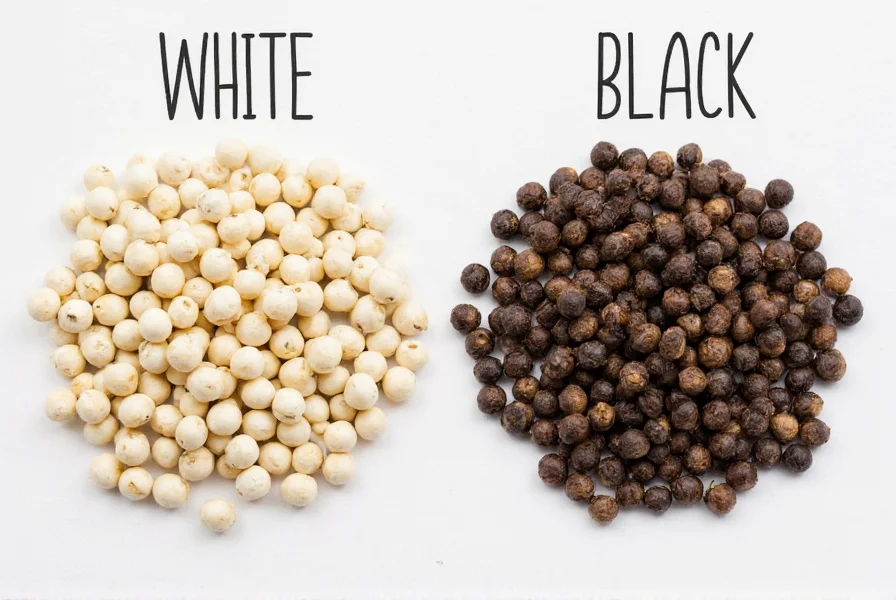Understanding the nuanced differences between these two staple spices can transform your cooking. Though they originate from the same vine-grown peppercorns, the processing methods create distinct flavor compounds that serve different purposes in the kitchen. Let's explore what makes each variety unique and how to leverage their specific qualities in your recipes.
Botanical Origins: Same Plant, Different Journey
Both black and white pepper derive from Piper nigrum, a flowering vine native to South India. The critical difference emerges after harvest, when processing methods alter the chemical composition and sensory characteristics of the peppercorns. This transformation affects not only appearance but also the volatile compounds responsible for aroma and taste.
Processing Methods: How They're Made
Black pepper production begins when nearly ripe green peppercorns are harvested and sun-dried. During this process, the outer layer (pericarp) undergoes enzymatic oxidation, turning dark and developing complex flavor compounds. The resulting black peppercorns contain piperine (the compound responsible for heat) along with additional aromatic compounds formed during fermentation.
White pepper follows a different path. Fully ripe red peppercorns are soaked in water for about a week, allowing natural fermentation to loosen the outer layer. After the pericarp is removed through rubbing, the remaining seed is dried, producing the characteristic pale color. This alternative processing method significantly alters the flavor profile by eliminating certain aromatic compounds present in black pepper.
| Characteristic | Black Pepper | White Pepper |
|---|---|---|
| Processing Method | Sun-dried with outer layer intact | Soaked and fermented to remove outer layer |
| Flavor Profile | Complex, earthy, floral notes with bold heat | Cleaner, sharper heat with musty undertones |
| Heat Level | Moderate to high (6-8/10) | Slightly higher perceived heat (7-9/10) |
| Best Culinary Uses | Meat rubs, hearty sauces, visible seasoning | Light-colored sauces, mashed potatoes, Chinese cuisine |
| Shelf Life | 2-3 years whole, 1 year ground | 1-2 years whole, 6-8 months ground |
Flavor Chemistry: Why They Taste Different
The key to understanding difference between white and black pepper flavor lies in their chemical composition. Black pepper contains approximately 5-9% piperine, plus additional volatile oils like pinene, sabinene, and limonene that contribute to its complex aroma. White pepper, lacking the outer layer where many of these compounds reside, has a more singular piperine-driven heat profile.
Interestingly, white pepper's fermentation process creates different compounds, including geosmin, which explains its characteristic earthy, sometimes musty notes. This is why many chefs describe white pepper as having "sharper" heat—it's not necessarily hotter chemically, but the absence of competing flavor compounds makes the heat more direct and immediate.

Culinary Applications: When to Use Each Variety
Professional chefs select between these peppers based on specific recipe requirements. Understanding when to use white pepper vs black pepper can elevate your cooking:
- Black pepper shines in robust dishes like steak rubs, dark sauces, and hearty stews where its complex flavor can complement other strong ingredients. Its visual presence also adds aesthetic appeal to finished dishes.
- White pepper excels in light-colored preparations where black specks would be undesirable—think béchamel sauce, mashed potatoes, or cream soups. It's also traditional in many Chinese and Vietnamese dishes, where its cleaner heat profile integrates seamlessly.
Contrary to popular belief, white pepper isn't inherently milder. In fact, many tasters perceive it as hotter because the heat hits immediately without the aromatic complexity that tempers black pepper's burn. This makes white pepper particularly valuable in dishes where you want pronounced heat without competing flavors.
Nutritional Differences and Health Benefits
Both varieties offer similar nutritional profiles since they come from the same plant. However, the black pepper processing method preserves more of the outer layer's compounds, potentially offering slightly higher antioxidant content. Piperine, present in both, enhances nutrient absorption—particularly for turmeric's curcumin—and has demonstrated anti-inflammatory properties in studies.
White pepper's fermentation process may create additional bioactive compounds, though research in this area remains limited. For maximum health benefits, both varieties work best when freshly ground, as the volatile compounds responsible for both flavor and potential health benefits degrade quickly after grinding.

Storage Considerations for Maximum Freshness
To preserve the distinctive qualities of each pepper, proper storage is essential. Whole peppercorns maintain freshness significantly longer than pre-ground versions. Store both varieties in airtight containers away from light and heat. Black peppercorns typically retain optimal flavor for 2-3 years when stored properly, while white peppercorns, being more processed, have a slightly shorter shelf life of 1-2 years.
When grinding, use a dedicated mill for each variety to prevent cross-contamination of flavors. The moisture content difference between the two can affect grinding consistency—white peppercorns are often drier and may require adjustment of your mill settings.
Addressing Common Misconceptions
Several myths persist about these spices. One common misconception is that white pepper is simply "milder" black pepper. In reality, as we've explored, it's chemically different with a more direct heat profile. Another myth suggests white pepper is inferior quality—it's actually a deliberate processing choice with specific culinary purposes.
The notion that one is universally "better" than the other reflects a misunderstanding of their complementary roles. Professional kitchens typically maintain both varieties because they serve different functions, much like having both kosher salt and fine sea salt available.
Practical Recommendations for Home Cooks
For everyday cooking, maintain both varieties in whole peppercorn form. Invest in a quality pepper mill that can handle the harder white peppercorns. When following recipes:
- Substitute black for white only in dishes where visual appearance isn't critical
- Use white pepper when creating light-colored sauces or dishes where black specks would be distracting
- Consider black pepper for finishing dishes where you want visible seasoning and complex aroma
- Grind fresh for critical applications, but pre-ground works for long-cooked dishes
Understanding these key differences between white and black pepper transforms them from simple seasonings into strategic culinary tools that can elevate your cooking precision.
Frequently Asked Questions
Can I substitute white pepper for black pepper in recipes?
Yes, but with considerations. White pepper can substitute black pepper in light-colored dishes where visual appearance matters, like cream sauces or mashed potatoes. However, the flavor profile differs significantly—white pepper delivers sharper, more direct heat without black pepper's complex floral notes. In robust dishes like stews or meat rubs, black pepper generally provides better flavor complexity. The substitution ratio is typically 1:1, but taste as you go since perceived heat levels differ.
Why does white pepper sometimes taste musty?
The musty flavor in white pepper comes from geosmin, a compound produced during the fermentation process used to remove the outer layer of the peppercorn. This earthy note is characteristic of traditionally processed white pepper. Higher quality white pepper undergoes careful fermentation and thorough washing to minimize excessive mustiness while preserving the desired clean heat profile. If your white pepper tastes unpleasantly musty, it may be old or poorly processed—fresh white pepper should have a clean, sharp heat with subtle earthiness, not overwhelming mustiness.
Which pepper has more health benefits?
Both contain piperine, which enhances nutrient absorption and has anti-inflammatory properties. Black pepper may offer slightly more antioxidants due to preservation of compounds in the outer layer during processing. However, the difference is minimal for typical culinary use. The primary health consideration is freshness—both varieties lose beneficial compounds over time, especially after grinding. For maximum health benefits, use freshly ground pepper from high-quality whole peppercorns within 6 months of purchase, regardless of color.
Why do some restaurants use only white pepper?
Many professional kitchens, particularly in French and Chinese cuisines, maintain both varieties but use white pepper for specific applications. Some restaurants might appear to use only white pepper because they're preparing dishes where visual presentation is critical—like consommé or white sauces—where black specks would be undesirable. In Chinese cuisine specifically, white pepper's cleaner heat profile integrates better with traditional flavor combinations. However, most professional kitchens actually stock both varieties for different culinary purposes.











 浙公网安备
33010002000092号
浙公网安备
33010002000092号 浙B2-20120091-4
浙B2-20120091-4